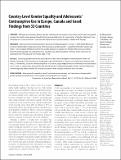Files in this item
Country-level gender equality and adolescents' contraceptive use in Europe, Canada and Israel : findings from 33 countries
Item metadata
| dc.contributor.author | de Looze, Margaretha | |
| dc.contributor.author | S. Madkour, Aubrey | |
| dc.contributor.author | Huijts, Tim | |
| dc.contributor.author | Moreau, Nathalie | |
| dc.contributor.author | Currie, Candace | |
| dc.date.accessioned | 2019-03-01T10:30:04Z | |
| dc.date.available | 2019-03-01T10:30:04Z | |
| dc.date.issued | 2019-03 | |
| dc.identifier | 256866813 | |
| dc.identifier | dd6a8aa0-f392-4f81-aba3-5e0798ee0c3d | |
| dc.identifier | 85062347984 | |
| dc.identifier | 000460947300005 | |
| dc.identifier.citation | de Looze , M , S. Madkour , A , Huijts , T , Moreau , N & Currie , C 2019 , ' Country-level gender equality and adolescents' contraceptive use in Europe, Canada and Israel : findings from 33 countries ' , Perspectives on Sexual and Reproductive Health , vol. 51 , no. 1 , pp. 43-53 . https://doi.org/10.1363/psrh.12090 | en |
| dc.identifier.issn | 1538-6341 | |
| dc.identifier.uri | https://hdl.handle.net/10023/17185 | |
| dc.description.abstract | CONTEXT Although an association between gender equality and contraceptive use has been confirmed among adult samples, few studies have explored this relationship among adolescents. An examination of whether adolescents’ contraceptive use is more prevalent in countries with higher levels of gender equality is needed to fill this gap. METHODS Nationally representative data from 33 countries that participated in the 2013–2014 Health Behaviour in School‐Aged Children study and country‐level measures of gender equality—using the 2014 Global Gender Gap Index—were analyzed. Multilevel multinomial logistic regression analyses were employed to assess associations between gender equality and contraceptive use (condom only, pill only and dual methods) at last intercourse as reported by 4,071 females and 4,110 males aged 14–16. RESULTS Increasing gender equality was positively associated with contraceptive use among both males and females. For every 0.1‐point increase on the equality scale, the likelihood of condom use at last intercourse rose (odds ratio, 2.1 for females), as did the likelihood of pill use (6.5 and 9.6, respectively, for males and females) and dual method use (2.1 and 5.6, respectively). Associations with pill use and dual use remained significant after national wealth and income inequality were controlled for. Overall, associations were stronger for females than for males. CONCLUSIONS More research is needed to identify potential causal pathways and mechanisms through which gender equality and adolescents’ contraceptive use may influence one another. | |
| dc.format.extent | 11 | |
| dc.format.extent | 210921 | |
| dc.language.iso | eng | |
| dc.relation.ispartof | Perspectives on Sexual and Reproductive Health | en |
| dc.subject | RA Public aspects of medicine | en |
| dc.subject | RJ101 Child Health. Child health services | en |
| dc.subject | 3rd-NDAS | en |
| dc.subject | SDG 5 - Gender Equality | en |
| dc.subject | SDG 10 - Reduced Inequalities | en |
| dc.subject.lcc | RA | en |
| dc.subject.lcc | RJ101 | en |
| dc.title | Country-level gender equality and adolescents' contraceptive use in Europe, Canada and Israel : findings from 33 countries | en |
| dc.type | Journal article | en |
| dc.contributor.institution | University of St Andrews. Population and Behavioural Science Division | en |
| dc.contributor.institution | University of St Andrews. WHO Collaborating Centre for International Child & Adolescent Health Policy | en |
| dc.contributor.institution | University of St Andrews. Child and Adolescent Health Research Unit | en |
| dc.contributor.institution | University of St Andrews. School of Medicine | en |
| dc.identifier.doi | https://doi.org/10.1363/psrh.12090 | |
| dc.description.status | Peer reviewed | en |
This item appears in the following Collection(s)
Items in the St Andrews Research Repository are protected by copyright, with all rights reserved, unless otherwise indicated.

